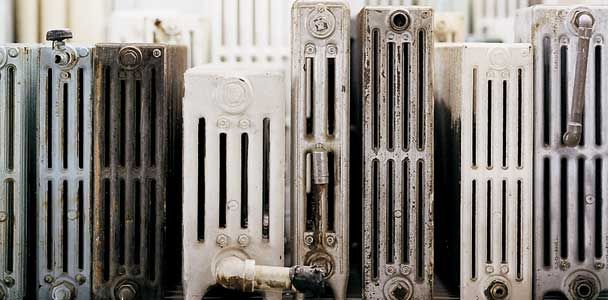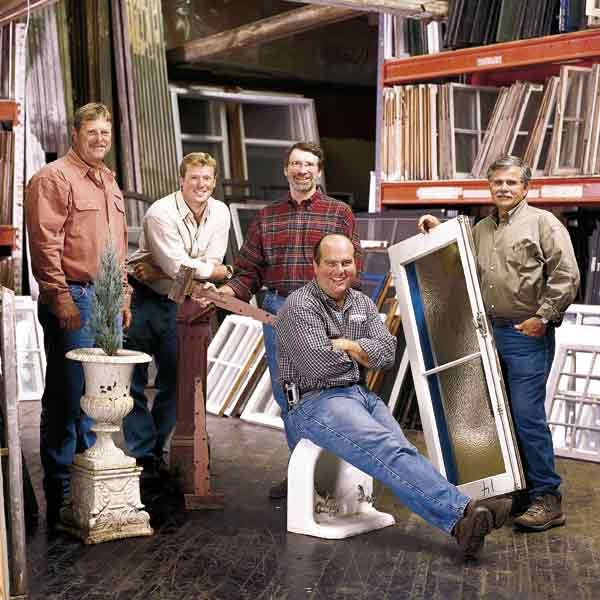
Whether they’re called junk shops, architectural antiques stores, or demolition depots, salvage yards are a treasure hunter’s dream. These cavernous warehouses are packed with neatly organized collections of old house parts: row upon row of paneled doors and porcelain sinks, cases filled with glass doorknobs and patinaed hinges, and backyards littered with iron benches and elaborate front gates. Some stock high-end reclaimed pieces side by side with lower-priced reproductions. Others hawk their wares online, allowing you to browse for bargains without leaving your living room.
These businesses make it easier than ever to find period parts to restore an old house or put character into a new one without paying for custom work. But while rummaging through a salvage yard is fun, the vast array of choices can be daunting. So on a recent trip to New England Demolition and Salvage in Wareham, Massachusetts, we asked the This Old House team for advice on how to tell the trash from the treasure.
Warning: Salvaged items are often coated with lead paint, so be sure to bone up on how to safely strip and dispose of the stuff.
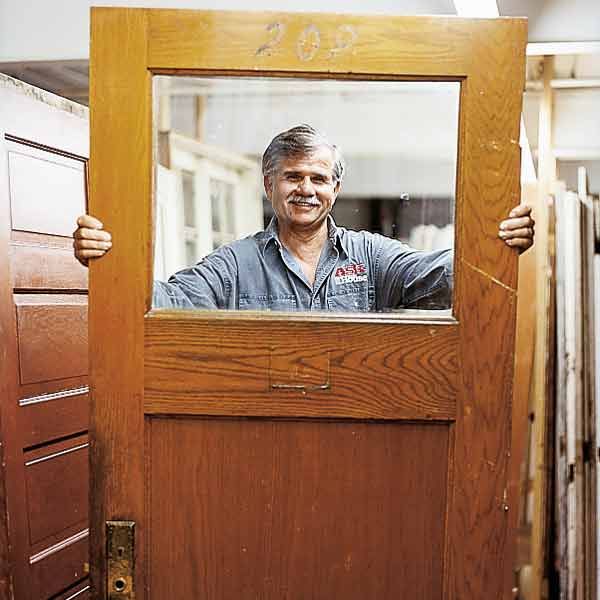
Architectural Features
The bulk of the salvage yard business is architectural elements—carved mantels, wood doors, and double-hung windows. Condition and price vary widely. Some dealers sell only near-mint-condition or restored pieces ready for installation; others sell dusty, paint-caked items to do-it-yourselfers willing to put in a little sweat equity in order to pay less. Many dealers offer turnkey refinishing and installation for a premium.
“Keep in mind that cleaning, fitting, and repairing an old piece is a lot of work,” says TOH general contractor Tom Silva. “But you’re also prolonging the life of some finely crafted piece that’s been around for years.”
Interior Doors
How to shop:
• Bring doorway measurements: from the inside of one side jamb to the inside of the other, and from floor or threshold to head jamb. Measure in several places, and note the largest numbers. Also note the direction of the door swing and which side the hinges are on
• Look for a door that’s ¼ inch smaller than each measurement to give you ⅛ inch clearance all around, or one that can be cut down to size.
• Choose stained or stripped doors, when possible, to avoid dealing with lead paint.
What to avoid:
• Twisted, cupped, or warped wood.
• Loose stiles and rails.
• Cracks, holes, or gashes in the wood, unless you plan to paint over big repairs.
• Doorknob holes that don’t match the location or type of latch on the jamb. “You don’t want to buy a door drilled for a mortise lock to install in a jamb with a tubular latch,” says Tom.
Expect to pay: About $40 to $250 per door.
Windows
How to shop:
• Bring dimensions. For a rough opening, measure between the framing studs and from the framing sill to the window header. For a replacement sash, measure between the side jambs for the width and measure the height of the sash itself by opening the window. If both sash are missing, measure from the sill inside the window to the header. Check both dimensions in three places and note the smallest.
• Look for a window that requires the least amount of repair to muntins, glazing, and joints.
• Consider curved, bay, Palladian, stained-glass, and leaded-glass windows as accent pieces in a new house.
What to avoid:
• Incomplete units. Missing sash, trim, weights, or pulleys will be hard to match.
• Mismatched glass. “A single window with modern glass will stick out like a sore thumb in a room full of wavy-glass windows,” says Tom.
Expect to pay: about $40 to $150 for a double-hung and $150 to $1,000 for stained-glass or other accent windows.
Fireplace Mantels
How to shop:
• Bring dimensions of the firebox opening, surround, and wall.
• Stick to the larger wood mantels or noncombustible stone. Old mantels are typically small and may not meet local fire codes—wood mantels usually require 6 inches of clearance from the firebox.
• Look for a mantel that matches the style and era of your house, or one that incorporates existing molding profiles in the room.
What to avoid:
• Exceptionally large and ornate mantels. “You don’t want it to overpower the room,” says Tom.
• Undersize mantels, though you may be able to bump up the height with blocks under the legs and extend the center with panels. Even so, you’ll need to have a new shelf made.
Expect to pay: Anywhere from $450 to $5,000, depending on wood, condition, size, detailing, and whether it has an overmantel. Marble mantels start at about $2,500.
Tom’s Tip: To check that a door is straight, tip it on one of its bottom corners and look down the edge. From this angle you’ll easily see any twisting or warping.
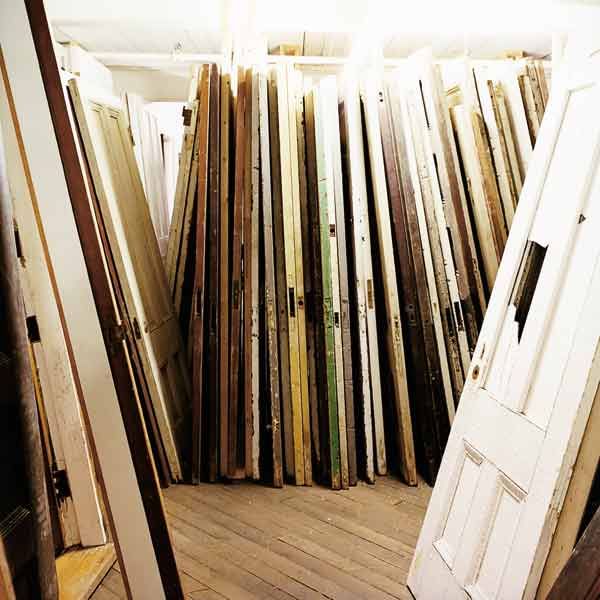
Plumbing Fixtures
Salvage yards are famous for stockpiling vintage sinks, claw-foot tubs, and cast-iron radiators. Plumbing and heating fixtures are typically sold “as is.” So before you buy, keep in mind that the fixture will likely need to be repaired, refinished, or—most difficult—retrofitted to comply with modern plumbing codes. “You don’t want to end up with a five-foot-long claw-foot planter in the backyard instead of a period soaker in the master bath,” says TOH plumbing and heating expert Richard Trethewey.
Tubs
How to shop:
• Bring your bathroom dimensions, including those for the tub recess, if there is one
• Climb in, lie back, and see how it feels. “You can’t beat an old claw-foot tub for comfort,” says Richard. They’re perfectly angled for reclining and hold more water than a modern tub of the same length because the overflow drains are higher (typically 16 to 18 inches above the tub floor, compared with 12 to 14 inches today).
What to avoid:
• Rust spots, dents, and missing feet, which are particularly hard to match.
• Peeling paint on the outside and worn, stained glaze on the inside. If a tub does need refinishing, it’s best left to a professional.
• Tubs with an undersize or nonexistent overflow. “That’s a flooded bathroom waiting to happen and a violation of most local plumbing codes,” says Richard. The overflow should be at least 2½ inches in diameter.
Expect to pay: About $150 to $1,500; refinishing starts at about $300.
Bathroom Sinks
How to shop:
• Keep in mind the style of your bathroom. Highly decorated baths can accommodate a curvy or elaborate sink, but contemporary baths call for clean lines.
• Consider space and installation constraints. Wall-mount sinks typically take up less room than pedestal sinks, but they are heavy and require support in the wall framing.
• Materials matter. Porcelain sinks tend to be finer than enameled cast-iron ones and typically don’t require refinishing.
What to avoid:
• Rust spots, dents, chips, and deep scratches in cast-iron sinks. Like tubs, they will probably need to be refinished by a professional.
• Bad crazing (crackling finish) on porcelain. This can’t be remedied.
Expect to pay: Upward of $150 for a cast-iron sink, $600 to $1,200 for porcelain.
Faucets and Fittings
How to shop:
• Measure the distance between the centers of the faucet holes on your sink and make sure any fittings you buy can fit this span. Faucet openings are typically 4 inches apart, but some go as wide as 6 inches or more.
• Match faucet connectors with those on your water supply valves at home.
What to avoid
• Incomplete sets. Missing faucet parts are almost impossible to find.
• Badly pitted chrome finishes. “Old fittings can be replated, but this is a labor of love, not logic,” says Richard.
Expect to pay: About $175 to $400 for a fully restored faucet set with handles.
Cast-Iron Radiators
How to shop:
• Figure out if you need a steam or forced-hot-water radiator. Radiators that have only one intake pipe at the bottom can only be used for steam systems. Hot water systems must have two pipes—one that feeds the radiator and a second that recycles cooled water back to the furnace—and the sections need to be connected at the top. Steam systems can also use two-pipe radiators.
• Try to match replacements with others in your house. Most yards stock tall, ornate Victorian-era radiators as well as squat, utilitarian designs from the 1940s and ’50s.
• Replace leaky or broken radiators with ones equal in size and output.
What to avoid:
• Throwing good money after bad. Stick to yards that test their stock for leaks and handle the dirty job of sandblasting units to remove old paint, then priming and repainting. Avoid those sold “as is”—they may leak or function as poorly as the ones being replaced.
Expect to pay: About $10 to $30 per section for radiators tested for leaks, slightly more for ones that have been refinished.
Richard’s Tip: Consider using a period sink that has separate hot and cold water faucets only in a powder room. Otherwise, when you want a warm splash in the morning, you’ll have to stopper the drain and mix the water in the basin—or risk getting scalded.

Decorative Details
In the far corners and back rooms of many salvage yards reside bins of old door hardware, bundles of wavy glass rescued from decrepit windows, and cubbies containing every period molding profile imaginable. Here’s where you’ll find that missing glass knob or door casing to restore a period entryway, or a pair of old iron strap hinges to lend instant provenance to a reproduction cabinet. “The age and rust of antique hardware add character to a new door or hutch,” says TOH master carpenter Norm Abram. “You simply can’t replicate that kind of surface texture and charm.”
Doorknobs
How to shop:
• When looking for a single replacement knob, bring along its mate. “You don’t want to spend the day riffling through a box of hardware only to discover that the knob you bought doesn’t fit on the spindle,” says Norm.
• Bring the measurement of your door’s thickness and compare it with the span between the knobs to ensure a snug fit.
• Choose complete knob sets, including the spindle and the set screw that attaches it to the knob.
What to avoid:
• Extreme wear and tear, such as deep scratches, chips, pits, and dings.
• Antique knobs on doors that need to be locked, because most don’t have the original key.
• Glass or brass knobs that have come loose from their collars, or bezels—this can’t be fixed.
Expect to pay: About $25 for a pair of simple white porcelain knobs and up to $100 for a single ornamental cast-bronze one.
Hinges
How to shop:
• Consider the age and style of your house and choose historically accurate designs or pick ones that echo other decorative details in the house.
• Keep utility in mind. Use weighty, substantial hinges on doors and save decorative butterfly hinges for cabinets.
• Know which side your door is hinged on and whether it swings in or out. Some old hinges are not reversible.
What to avoid:
• Incomplete sets. Make sure you have both hinge plates and the center pin, and that the hinge pivots smoothly.
• Mismatched finishes. You’ll rarely find more than a few pieces in the same pattern and finish. For a matched set, take your mixed bag to a professional plating shop and have them refinished together.
Expect to pay: About $20 for a pair of plain cast-iron door hinges, upward of $100 for more fanciful cast-brass butt hinges.
Trim
How to shop:
• Look for unpainted or stained pieces that don’t need to be stripped, to avoid dealing with lead paint.
• Don’t expect to find enough to finish an entire room. Salvaged trim is best for replacing a single casing or short length of damaged molding.
• For larger amounts of a salvaged profile, take it to a millwork shop for duplicating. What to avoid:
• Dry rot and wormholes.
• Aggressively refinished profiles—fine details may have been sanded off.
Expect to pay: About $4 to $10 a foot.
Old Glass
How to shop:
• Choose a piece that’s ⅛ inch smaller in width and length than the window opening so the glass can move as the wood expands and contracts.
• When you have to trim the glass to size, choose a pane a couple of inches bigger than you need so it will be easier to cut.
• If you can’t find a pane of the right size, you may have to buy an entire sash and remove the glass yourself.
What to avoid:
• Coming up short. Buy extra glass in case you make a mistake. “The ripples that make this glass charming also make it hard to cut,” says Norm.
Expect to pay:
About $3 a square foot.
Norm’s Tip: To trim a glass pane, dip a glass cutter in kerosene or 3-in-1 oil and score the cleaned glass once, using moderate pressure. Move the score line to the edge of the worktable, then gently snap off the cantilevered section with a gloved hand.
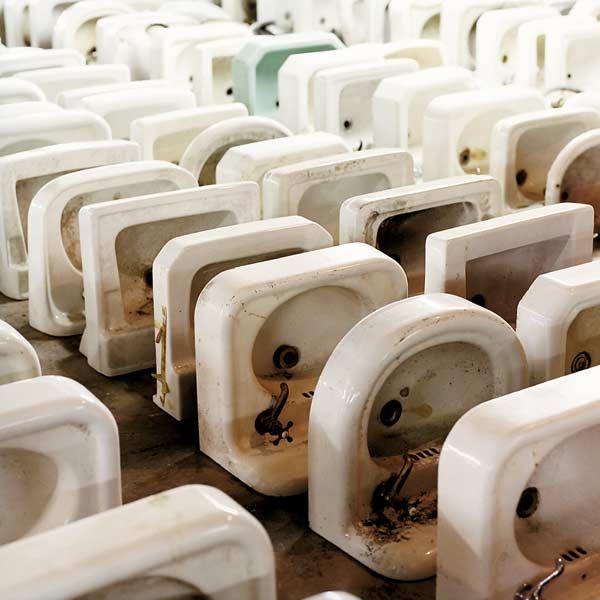
Outdoor Ornaments:
Unlike new patio furniture and clay pots with flawless finishes, the rusty iron urns, graying wooden trellises, weathered granite birdbaths, and crumbling terra-cotta statuary you find at salvage yards are prized for signs of age. Flaking paint and stress fractures from years of exposure to the elements help such ornaments blend with all but the most modern landscape designs. “It doesn’t fit in the garden if it’s shiny,” says TOH landscape contractor Roger Cook. “You want garden elements to look like they’ve been there forever.”
Wood Trellises and Arbors
How to shop:
• Determine how you’re going to use them. “A single, strategically placed flat wood trellis and a fast-growing vine are perfect for obstructing an unsightly view,” says Roger. A pair makes a nice frame for a door opening.
• Look for redwood, cedar, mahogany, or teak, which hold up better than most pines or poplar.
• Consider condition. Trellises and arbors usually come “as is,” with peeling paint or dry, graying wood. To preserve the wood and its aged look, knock off loose paint with a soft wire brush and apply a coat of clear deck sealant.
What to avoid:
• Severely rotted or insect-damaged wood.
• Weak structures—though new timbers can be used to shore them up.
Expect to pay: About $50 to $400 for a single flat trellis, up to $5,000 for a carved wood rose arbor with ornate columns.
Photo: Keller & KellerOrnamental Ironwork
How to shop:
• Look for designs that reflect the character of your landscape. For a formal garden, try an ornate cast-iron bench or a marble-topped bistro table. A more rustic location will look better with a simple wooden two-seater with wrought-iron sides.
• Be creative with limited quantities. You can use short sections of iron fencing to break up long expanses of a stone wall, for instance, giving visitors a peek at plantings on the other side.
What to avoid:
• Pieces that have been aggressively refinished or sandblasted. This may have ruined a well-worn patina or knocked off delicate details.
Expect to pay: About $400 to $2,000 for a cast-iron bench; $200 to $600 for a 3-foot section of iron fencing.
Planters
How to shop:
• Consider material, condition, color, and patina to determine whether it fits in with the character of your garden and its decorative elements.
• Check whether you’re buying a reproduction or an antique—many yards sell both. Reproduction stone urns typically weigh less.
• Look for large containers that can serve as centerpieces or enliven the corners of a garden. Filled with plants of varying heights, colors, and textures, they become focal points.
What to avoid:
• Antiques may not be for you if you’re not willing to give them extra care. Fragile containers should be moved indoors—or at least onto a covered porch—to keep them from cracking further in winter.
Expect to pay: About $150 to $500 for a cast-stone or terra-cotta container, into the thousands for sculpted granite, marble, limestone, and some ornate cast-iron containers.
Roger’s Tip: To preserve the rusted look of iron ornaments without encouraging further decay, give them a light sanding with 000-grit steel wool, rinse with water, and let dry. Then spray thoroughly with a couple coats of clear, rust-resistant enamel.
